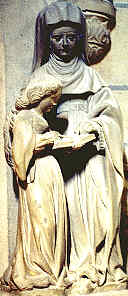 |
|
Reading, Writing, Hearing, Speaking and Remembering |
| I have recently reached the stage in my life when I have grandchildren learning to read and write, and it is a source of fascination and despair to discover that the debates about the correct way to learn these skills seem to have changed not one jot since the previous generation set about the process. In fact, I'm not so sure that they have changed since I learned. Not only do educators seem to want to believe that there is one right way to teach literacy today, they seem to be unaware that in the past, reading and writing were not always conceptualised or carried out as they are today. A look at the relationship between readers and writers and the graphic signs that they used to communicate with in the medieval era reveals a complex world of interaction. |
|
| St Anne teaches the Vrigin to read in a late medieval sculpture in the tiny church of Fontaine-les-Dijon in Burgundy, France. |
| There are different processes of reading, of writing and of being educated for literacy. These changed over the course of the middle ages as literacy expanded through a greater proportion of the community and served a wider range of functions in society. This very brief introduction to the subject will attempt to divide the whole literate process into its components, in order to examine in how many different ways people could be literate in the medieval era, and how they accomplished it. |
|
|
Reading and Remembering  |
Reading, Writing and Oral Transmission  |
Education for Literacy  |
 The
Concept of Literacy The
Concept of Literacy |
|
 |
 |



